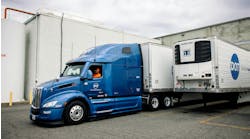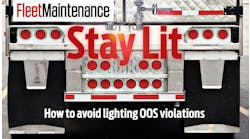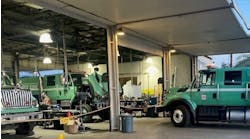How long have you been in maintenance management? Ten years? Twenty years? Maybe thirty? And, how did you get to your current management position? Was the career ladder mapped out for you, or did you have to create your own job?
For some fleet maintenance professionals, it's an easy climb to a management position. But once they're there, how do the best managers stay on top?
Many have found an answer in the Certified Automotive Fleet Manager (CAFM) program, offered by the National Association of Fleet Administrators (NAFA). In a profession that has no "official" curriculum, degree program or career track, the CAFM program is a beacon of light for fleet managers who never want to stop learning.
That's how it was with Rick Hilmer, CAFM, fleet maintenance supervisor for Prince George's County, MD, Department of Public Works and Transportation. After over 12 years in fleet management for the County, Hilmer had spent a lot of time networking with other area fleet professionals who had acquired the CAFM and CFM titles (CFM is an earlier version of the same program), and he respected the level of knowledge and professionalism that his colleagues displayed. At the same time, he was a strong advocate of technician certification through the National Institute for Automotive Service Excellence (ASE) for his 12 technicians.
"It was one of those things where I kept saying, ‘One day... one day I'll do this,'" Hilmer recalls. "And, a lot of us have put the push on our staffs in recent years, as far as ASE goes: on the one hand, encouraging them to be ASE certified, and extolling the virtues of that, and on the other hand working with our agencies to develop incentives for that… and one day I was giving somebody the spiel on why they should be certified, and it just dawned on me that, ‘How can you sit here and tell people all these great reasons why they need to be certified, and there's a certification program for you, and you're not doing it?' It kind of snuck up on me."
When Hilmer made the decision to pursue a CAFM three years ago, while he was with the County's Park & Planning Commission, he planned to proceed at a comfortable pace. But once he began the two year program, he found that many of his preconceived notions fell by the wayside.
CRACKING THE BOOKS
The first surprise for Hilmer came when he realized that the program followed a very strict and rigorous schedule.
"Once I sent that application in I was on the clock, because I had to get this done in that period of time," he says. "It was a little overwhelming, because I had this idea in my mind of what pace I was going to be working at, and how I was going to do it. And the program was more structured than I thought previously.
"So in other words, they had me on a timetable," he continues. "I just thought I'd take a class or two a year and sooner or later I'll get there, and that's not how it was. There was a six-month period of time in which I had four courses to complete, and they were pretty tough."
The structure of the program is dictated by NAFA's "Education Competency Model," according to NAFA director of education Joe Dunne. "The Education Competency Model is divided up into seven disciplines, and one of those disciplines is maintenance management," he explains. The other disciplines are: asset management, business management, financial management, fleet information management, risk management, and vehicle fuel management.
"They gave us these giant binders for the four courses that made up a semester," Hilmer says, "but that didn't work for my way of thinking, so the first thing I did was I disassembled the whole thing and put them into individual course binders."
Hilmer flips through the course binder he put together for his maintenance classes, showing off the detailed technical sections dealing with such topics as ‘Gas vs. Diesel,' ‘Alternative Fuels,' ‘Spec'ing Trucks,' and ‘Maintenance Shop Operations.'
"A lot of the classes have a broad focus, like ‘Principles of Supervision and Management,'" he says, "but then they add onto that more specific things, where they talk about current issues in fleet management, so you can start to relate some of the principles that you've learned to specifics."
WHO NEEDS CAFM?
There are currently over 160 CAFMs working in the fleet industry, according to Dunne, who oversees the CAFM program, and works with the certification board to make sure that the course content is relevant, comprehensive and up-to-date.
As Dunne explains, many people enroll in the CAFM program because their employer requires it, while many others pursue it for the knowledge and experience they hope to gain. Some CAFM candidates are technicians with a high level of vehicle expertise but no management experience, while others are experienced managers who are completely new to the world of vehicle management. Indeed, as Rick Hilmer points out, "really and truly it's amazing that there are people who have the exact same job title in this business, whose jobs look nothing like each other, and they have very little in common in terms of how they work and what they're responsible for."
"We're providing them the broadest, most comprehensive training program we can, specifically because we know that there are different kind of fleet managers, different kids of fleet administrators," Dunne explains. "Some are going to be more concerned with asset management, some are going to be more concerned with maintenance management. Some are going to work for government fleets that have their own shops, some are going to work for corporate fleets that are outsourcing almost all of their maintenance. But, whatever the emphasis in your job, you're going to find value in our program."
FINDING VALUE
Over the two-year study plan, CAFM candidates take a total of eight courses, in two groups of four, and are tested on those. Usually that comes in the form of a proctored examination at a local community college.
When Hilmer went through the program, that test was followed by a "case study" exercise, in which he was presented with a real-world fleet management issue and then tasked with writing a detailed report on how to address that issue.
Although NAFA has recently reworked the CAFM program and replaced the case study with a new study module, it's still worth looking at the challenges Hilmer faced in doing what he describes as "the most work I've done on anything since college."
THE CHALLENGE
"They give you a package of information, and essentially give you a challenge," Hilmer recalls. "The idea is that you're in a working environment, and your boss has given you an assignment to research an issue and provide a well-organized position paper. In other words: this is where I think our organization needs to go on this issue, and here's all my background information and my research and here are my findings of fact, and here is my recommendation.
"The first thing that popped into my mind as I read through that was that I knew the answers to every one of those things," he says. "He wants to know whether we should do A or B? Well, we're going to do A."
But a funny thing happened when Hilmer started to research the problem: he found that none of his assumptions were correct.
"I had to throw my assumptions out; it didn't work," he admits. "It was like a wake-up call to me. This forced me to recognize that I am set in my ways in some fashion, and that I do have certain assumptions, that may be based on some amount of experience. But this business is always changing, it's always evolving."
After throwing out his initial attempt, Hilmer tried again, producing a 50-page report that ultimately earned him the CAFM.
CHANGING COURSE
On a practical level, NAFA changed the case study to allow more frequent testing and quicker turnaround. But on an educational level, Dunne explains, the new Education Competency Model demanded a more comprehensive study exercise than the very specific case study model would allow.
"Our program now, we feel, is more comprehensive, and of more value to fleet managers," Dunne explains, adding that the challenging learning experience Hilmer praises in the old model will still be present in the new one. "The curriculum is research-based for all seven of the disciplines, so rather than have that effect simply for one specific area, we're hoping to produce that effect across the seven disciplines."
While the educational experience remains the same, the new model is changing the way students can integrate the program into their working lives. Courses are now available online or on CD, and will eventually be online exclusively and updated every four months, to coincide with testing dates in February, May and October of each year.
"We're aware that the shelf life of a lot of the information changes quite quickly, and we're interested in being ahead of the curve," Dunne says, adding that NAFA will be announcing more training and certification news later this year.
THE CREDIBILITY FACTOR
Today, Hilmer is thinking ahead to his CAFM recertification, required every five years. By March, 2009, he has to earn 80 "credits" in areas such as community service, making legislative contacts, writing articles for publication, attending local NAFA educational programs, and attending the NAFA Fleet Management Institute.
"I have to be out there participating in the fleet world, not just sitting here in my shop doing things the way I think they need to be done, thinking I don't need to talk to anyone else," he says.
For Hilmer, the CAFM has benefited him in countless ways. "The knowledge gained from the program has really helped me to be able to communicate intelligently with folks in Legal, Finance or Risk Management about specific situations," he says. "They often seemed to be surprised that someone from Fleet is familiar with their areas of expertise, and it has given me credibility when I have issues which need to be resolved."
For more on the CAFM program, visit www.nafa.org.
Don't think CAFM is for you?
If the CAFM program from NAFA doesn't suit your needs, there are two alternatives, offered by the North American Transportation Management Institute (NATMI), of Denver, CO.
Joel Morrison, director of business development for NATMI, describes the two fleet maintenance certification programs offered by this not-for-profit organization:
"In the maintenance area, we offer two programs. The first one is Certified Supervisor of Maintenance and Equipment, the second one being Certified Director of Maintenance and Equipment.
"Certification validates a skill set, but the benefits are different for everybody. Most people will say, "I want to improve my managerial or technical competence," or, "I'd like to have a credential that advances my career, but I'm also looking for something that establishes my professional reputation," or, "I want to improve my on-the-job performance." Some folks come to us because they want their credential recognized in courtroom testimony. The real value, from our perspective, is performance improvement.
"In maintenance, it's one thing to learn how to fix the equipment; it's another thing to learn how to manage the operation of maintaining it. This program fills in those gaps."
LEVELS OF EXPERIENCE
"The difference between our Supervisor of Maintenance Certification and our Director of Maintenance Certification is that one person implements policy, the other person writes that policy. Our certification program takes into account how many years of experience the person has. For example, the Supervisor of Maintenance Certification requires that they have a minimum of two years of experience in the maintenance field. The Director of Maintenance Certification requires five years in the maintenance field, or four years with a four year college degree. There is also certain expertise that is also taken into account.
"The Director of Maintenance Certification candidate is a full-time administrator, demonstrating their capability of handling a position which involves establishing programs, writing policy, setting standards, developing materials and providing leadership to achieve goals set in the shop.
"The Supervisor of Maintenance Certification candidate is typically going to be someone who was on the shop floor and has been made a supervisor now, at the shop level. It's taking that person and transitioning him from a technician to a supervisor role.
"The Supervisor of Maintenance Certification candidate implements the policy written by the Director. Those supervisors are the people who have the ability to carry out policy and program directives. They are expected to administer programs, provide leadership at the shop level, and engage in the development of programs that are established by their managers.
"Some of these people come up from the shop floor and they feel a lot of pressure. They say, ‘I'm not a supervisor. What am I doing here?' The fleets are finding it hard to give these people the skill sets they need to be effective as supervisors. And the core of our programs give these folks those skill sets."
POSITIVE IMPACT
"From a maintenance perspective, a lot of it is about lowering vehicle maintenance costs, and that's really where we start with the two certification programs we have for fleet maintenance. Though the overall professional development aspect is the crux of why people come to us, the positive impact that our programs have on the company bottom line is usually why the company stakeholders want them to go through our program. So the returns are pretty significant.
"What sets us apart is that all of our programs are University accredited. These are college degree level programs, built on very rigorous course design standards. NATMI itself was established in 1944 at Penn State University, however today we are affiliated and accredited through Embry-Riddle Aeronautical University's Center for Integrated Transportation Safety and Security (CITSS). They're the ones who oversee our certification process, and accredit the NATMI training programs. They administer our certification exams, and they're also that third objective party that oversees the granting of certified status. They also monitor our course development to insure they meet university-level instructional design standards.
"We're partnered with 33 of the State Trucking Associations. The courses are all instructor-led, and they're scheduled pretty regularly through the State Trucking Associations. We also have some national partners, like the American Trucking Associations (ATA), American Bus Association, American Moving & Storage Association, and the Truckload Carriers Association."
Fleet Maintenance Certification Courses
Essentials of Fleet Maintenance Management
Course benefits:
- Learn why computers save money but don't always reduce labor costs;
- Learn to schedule work effectively;
- Discover the common pitfalls of computer software;
- Develop supervision skills to motivate mechanics;
- Find out what "ground work" needs to be done before a shop goes "on-line";
- Learn essential preventive maintenance skills;
- Learn how to deal with upper management effectively;
- Find out how to train mechanics on nearly anything without spending a fortune;
- Learn how to present effective meetings and programs; and
- Understand the maze of state and federal rules that cover maintenance operations.
Course Description:
The program covers topics essential to effective management and administration of motor fleet maintenance operations.
Students learn how to cut costs through efficient use of personnel, equipment, and technology, while complying with the maze of State and Federal regulations governing maintenance operations.
- Shop Equipment: equipping for shop safety and compliance and the environment; special tools and equipment.
- Maintenance Shopwork Planning and Scheduling: shop administration; improving maintenance cost control.
- Preventive Maintenance: administering a preventive maintenance (PM) program; how program is monitored, enforced, revised; related factors in setting up a PM program.
- The Functions of Management: the maintenance/equipment manager; the framework of management; running successful shop meetings; quality management systems.
- Maintenance Budgeting: tracking costs; calculating Cost Per Mile and Revenue Per Mile; developing a budget.
- Computers in Maintenance: why, how and what to computerize; steps in choosing the ideal system; organizing your information management system.
- Federal Regulations Applicable to Maintenance
- Shops: OSHA, EPA, HazMat, Motor Carrier Safety Assistance Program, compliance and training programs.
- Labor and Industrial Relations: overview; collective bargaining sessions; management procedures that can reduce grievance rates; strategic involvement.
- Training: The supervisor's role in training; principles of adult learning; effective on-the-job training.
Cost Containment Strategies for Fleet Maintenance Managers
Course benefits:
- Discover the tools available to spec' equipment in the computer age;
- Develop a systematic method to evaluate new products;
- Find out how to maximize warranty recovery;
- Learn how to cost out new equipment, and develop ROI numbers;
- Learn to speak the CFO's language;
- Learn the technical characteristics of alternative fuels;
- Discover the common pitfalls in laying out a new shop;
- Learn how to replace components just before they break;
- Ascertain what it takes to move from one generation of computerization to the next; and
- Learn how to audit to find out where you are in relation to your department's goals.
Course Description:
You'll learn how to effectively spec' vehicles, purchase wisely, negotiate warranty and best select suppliers and manufacturers.
You'll gain an in-depth knowledge of today's computerized management systems. You'll learn how to reduce costs through predictive maintenance, and how to properly analyze failures when they occur - and more.
- Vehicle Specifications : Developing vehicle specifications; evaluating component choices; using mission simulations to predict performance.
- Purchasing: selecting vendors, negotiating terms; evaluating parts quality and warranty.
- Warranty: vehicle warranties, extended coverage's; federally required coverage; policy adjustments; negotiation.
- Computerized Management Systems: Identifying needs and wants; evaluating software and hardware choices.
- Advanced Budgeting and Financial Statements : Writing budgets; cost justification; communicating with the finance department.
- Failure Analysis and Predictive Maintenance : Develop your own predictive maintenance program and prevent recurrent repairs through failure analysis.
- Shop Layout and Design : Planning new facilities and expansions; designing your shop for safety and the environment.
- Diesel and Alternative Fuels : A look at the pros and cons of currently developing alternatives to diesel power.
- Shop Audits : Evaluating all aspects of the maintenance program.
These courses have been approved for Continuing Education Units through The University of Central Florida
For more information, go to www.natmi.org.



